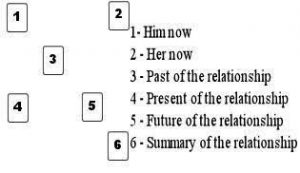The question of spreads
Once you get into the Tarot, it will not be long before you find the HUGE number of different spreads you can do with the cards. Every year there seems to be a new spread out there which promises you will get more information from.
These spreads vary from ones that focus on relationships, work, to a decision to make. There are also the more generic ones you see out there, such as the past/present/future spread or the traditional Celtic Cross spread.
In our eagerness we often try lots of different spreads and often try to focus on ones that make it easier to read the cards, therefore staying away from the more generic spreads and playing it more safe with fixed outcomes of each cards placement.
In the early stages, this is not a terrible strategy to use as you gain more experience with the cards. However, it is my opinion that after some time you should move towards the open-ended generic spreads. Once time has been spent refining reading the cards using generic spreads, then the genuine fun can begin where you can create your own open-ended spreads that you use consistently in your own practice for ANY question.
There are reasons for this. Say, for example, a client comes to you with wanting to know more about a relationship problem. Sidestepping the fact this is an ethical minefield etc. you use a relationship spread such as the one below to get more of an answer.

Fortunately, the traditional cards made sense in the areas they were found, and you could apply their meaning effectively. The client you read for was satisfied and you concluded the reading.
Now again it is important to note there is nothing wrong with doing readings like this, particularly in the beginning. However, when this method relied upon you miss out on improving your intuitive abilities with the cards as you only relate the card to its fixed outcome and rarely take as many risks, which any teacher of the intuitive arts will tell you is a must. Also, in many of these spreads and this also goes for the more generic ones, you are often not encouraged to draw any more cards. This not only inhibits your understanding of how different cards interact with each other and thus change meaning, but also you miss out on giving much more depth to your client.
This lack of depth is also apparent in another way when you use this method of reading. Although the clients question was about a relationship, by using a fixed spread instead of a more open one you have limited what the cards could point at such as other issues in the client's life that may be important. You have also sub consciously put the brakes on in your intuition as you will stick more rigidly to each area within the spread.
For example, by using a more open-ended spread, the cards might point you to a much earlier event that took place in the year. This event triggered a memory within the client of how they got treated in a past relationship and this then affected how they saw their current relationship. Because of this they then started to look at ways to self-sabotage it, even though the relationship was a wonderful one. The client admits that this is the case and is empowered to decide (not be told!) their best course of action, but with a greater understanding of their perception of the situation. They go away not only satisfied with the reading but have a better understanding of themselves which might even unfold into even greater depths.
That example was authentic of a reading I did with a client and would never have happened if I had used a fixed spread. Therefore, it’s important to try out more generic spreads, maybe not even asking the client what they would like to know more about, instead allowing the cards to tell you and then using them as a platform for your intuition. Then after that has become more comfortable using these generic spreads as a foundation to make your own spreads, forming a unique and personal relationship with your cards.
How I use my own spreads is simple. If a client is only having a short reading, I use a three-card spread, where the middle card is the most important and the two cards either side influence that card. This spread makes using the elements a lot easier to further enhance your reading and is something I will discuss in the next section. If I want further clarity on a card, I will draw another and place it under that card and go from there. I also use the bottom of the deck card to give me an overarching ‘theme’ of the reading and I treat that card importantly.

For more detailed readings I use an individualised Celtic Cross, allowing the cards to tell me what has happened/what is happening with sthe client and ultimately why they are here. However, for each section I pull out a further two cards on either side, like I would for the shorter reading above. Again, the bottom card of the deck holds significant value for myself.

Ultimately all the above is only my opinion on how I feel the best way to get the most out of different spreads. However, the biggest take home is the fact that so many readers need to take greater risks in their readings and begin to create their own relationship with their cards and a great place to start with is by creating their ‘own’ spreads.


